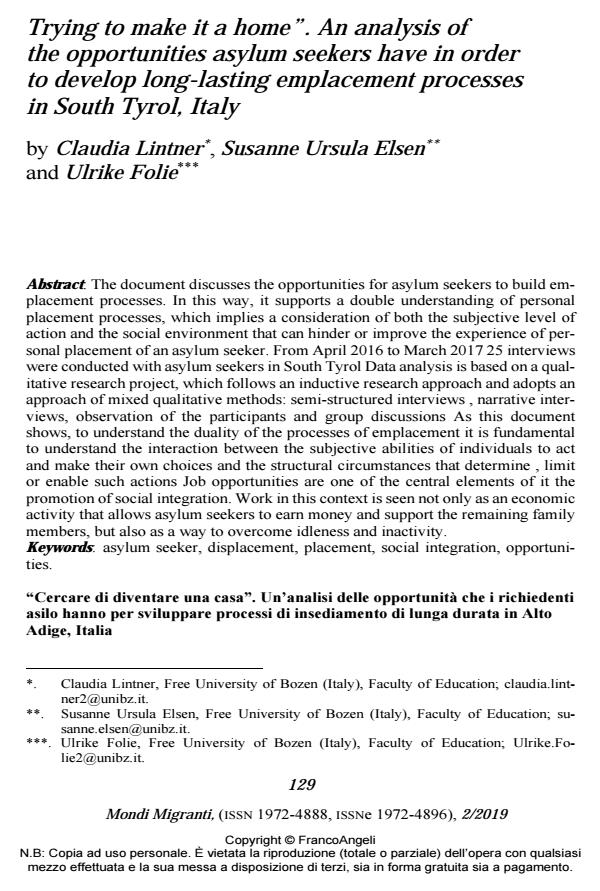"Trying to make it a home". An analysis of the opportunities asylum seekers have in order to develop long-lasting emplacement processes in South Tyrol, Italy
Titolo Rivista MONDI MIGRANTI
Autori/Curatori Claudia Lintner, Susanne Ursula Elsen, Ulrike Folie
Anno di pubblicazione 2019 Fascicolo 2019/2
Lingua Inglese Numero pagine 19 P. 129-147 Dimensione file 184 KB
DOI 10.3280/MM2019-002007
Il DOI è il codice a barre della proprietà intellettuale: per saperne di più
clicca qui
Qui sotto puoi vedere in anteprima la prima pagina di questo articolo.
Se questo articolo ti interessa, lo puoi acquistare (e scaricare in formato pdf) seguendo le facili indicazioni per acquistare il download credit. Acquista Download Credits per scaricare questo Articolo in formato PDF

FrancoAngeli è membro della Publishers International Linking Association, Inc (PILA)associazione indipendente e non profit per facilitare (attraverso i servizi tecnologici implementati da CrossRef.org) l’accesso degli studiosi ai contenuti digitali nelle pubblicazioni professionali e scientifiche
The document discusses the opportunities for asylum seekers to build emplacement processes. In this way, it supports a double understanding of personal placement processes, which implies a consideration of both the subjective level of action and the social environment that can hinder or improve the experience of personal placement of an asylum seeker. From April 2016 to March 2017 25 interviews were conducted with asylum seekers in South Tyrol Data analysis is based on a qualitative research project, which follows an inductive research approach and adopts an approach of mixed qualitative methods: semi-structured interviews , narrative interviews, observation of the participants and group discussions As this document shows, to understand the duality of the processes of emplacement it is fundamental to understand the interaction between the subjective abilities of indi-viduals to act and make their own choices and the structural circumstances that determine , limit or enable such actions Job opportunities are one of the central el-ements of it the promotion of social integration. Work in this context is seen not only as an economic activity that allows asylum seekers to earn money and sup-port the remaining family members, but also as a way to overcome idleness and inactivity.
Il documento discute le opportunità dei richiedenti asilo di costruire processi di em-placement. In tal modo, essa sostiene una doppia comprensione dei processi di col-locazione personale, che implica una considerazione sia del livello soggettivo dell’agire che dell’ambiente sociale che può ostacolare o migliorare l’esperienza di collocamento personale di un richiedente asilo. Da aprile 2016 a marzo 2017 sono state effettuate 25 interviste con richiedenti asilo in Alto Adige. L’analisi dei dati si basa su un progetto di ricerca qualitativo, che segue un approccio di ricerca indut-tivo e adotta un approccio di metodi qualitativi misti: interviste semi-strutturate, interviste narrative, osservazione dei partecipanti e discussioni di gruppo. Come mostra questo documento, per comprendere la dualità dei processi di emplacement è fondamentale comprendere l’interazione tra le capacità soggettive degli individui di agire e fare le proprie scelte e le circostanze strutturali che determinano, limitano o abilitano tali azioni. Le opportunità di lavoro sono uno degli elementi centrali nella promozione dell'integrazione sociale. Il lavoro in questo contesto è visto non solo come un'attività economica che consente ai richiedenti asilo di guadagnare denaro e sostenere i familiari rimasti, ma anche come un modo per superare l’ozio e l’inattività.
Parole chiave:Richiedente asilo, dislocamento, collocazione, integrazione sociale, opportunità.
- The evolution of the Italian reception system for asylum seekers into a "non-place" for "non-subjects" Ivana Acocella, in MONDI MIGRANTI 1/2022 pp.201
DOI: 10.3280/MM2022-001011
Claudia Lintner, Susanne Ursula Elsen, Ulrike Folie, "Trying to make it a home". An analysis of the opportunities asylum seekers have in order to develop long-lasting emplacement processes in South Tyrol, Italy in "MONDI MIGRANTI" 2/2019, pp 129-147, DOI: 10.3280/MM2019-002007